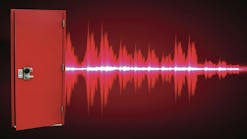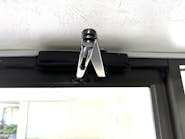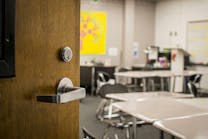When we think of accessible door and hardware solutions, Americans with Disabilities Act (ADA) requirements come to mind first — and they should. They’re the law.
Of course, accessible solutions can extend beyond those outlined for ADA compliance. Optional sliding doors, special closers, mobile credentials, wave-to-open sensors, acoustic door products and other ergonomic advancements are available to make access easier, doors safer to operate, openings touchless and environments more conducive for productivity. Although most of these might not be required by ADA, they often are desirable and certainly nice to have.
Today’s security pro should be prepared to provide solutions for accessibility, as well as for safety and security. It’s important for security pros to be aware of all available options.
ADA Arrives
ADA became a civil-rights law in 1990. Enforced by the Department of Justice, ADA was established to help people who have disabilities to gain access to places and opportunities that once were limited only to those who didn’t have disabilities. The law’s protections apply to all areas of life, including jobs, education, entertainment and transportation, as well as the ability to independently access all public and private spaces designed to accommodate the general public.
Not only is ADA compliance mandatory and the ethical and compassionate thing to do, it also is good business — a smart practice that can protect an organization’s valuable reputation as well as its bottom line. After all, it makes no sense to be among the thousands of costly cases filed every year by people who have disabilities against companies that don’t comply.
The most common accessible door solutions center around door levers, pulls, door bottoms, thresholds, closing mechanisms, daylighting glass and maneuvering clearances. When I started in the industry, we had doorknobs and thumb pieces on exit devices. After ADA passed, everything moved to levers and pull handles that don’t require a tight grasp, a pinch of a thumb or a twist of a wrist to operate. For instance, today’s levers can be operated easily by using a closed fist, and special pulls are available that can accommodate a forearm or elbow. This requirement, however, doesn’t apply to keys, keypads and card readers.
Door Closers, Opening Force
Public access openings require mechanical door closers, so it’s important to note carefully the types of mechanisms ADA allows as well as opening-force requirements. In general, those who have special needs have less physical strength, which is why ADA specifies that the maximum force to pull or push open an interior door has to be 5 pounds, noted as 5 lbf. Fire doors are exempt, because 5 lbf might not be enough to overcome the friction of the latch, smoke seal, etc.
Sweep speed is a standard valve on most commercial door closers and can be adjusted to meet the 5 seconds minimum for the door to travel from a 90-degree-open position until 12 degrees before latching. Another optional feature for commercial door closers is delayed action. This valve can be adjusted so when the door is opened fully, it doesn’t start the closing cycle until the end of the delay period, which allows a person more time to get through the doorway without having to fight with the door. Although it isn’t required by ADA, it’s an inexpensive option that can be helpful.
Essentially, there are two types of door closers: rack and pinion and cam and roller. Cam-action door closers are more efficient than surface-mounted models at maintaining the correct amount of power to close a door securely.
Originally, there were similar ADA opening-force regulations for exterior doors, but it soon became apparent that even 8 lbf was too light an amount of force, because it often prevented doors from closing fully and latching securely, particularly in windier locations.
As a result, a national ADA requirement for exterior doors to meet any type of opening force was dropped. However, states, such as California and Indiana, have their own accessibility codes that are more restrictive than ADA, so always be sure to check your local codes.
Specific standards for door closers are included within ANSI A146.4-4.3.
Doorway Requirements
ADA standard dimensions for swinging doors are a minimum of 80 inches in height and 32 inches in width (48 inches maximum width). Most commercial doors are 36 inches wide, which allows for at least a 32-inch-wide clear opening. Levers, pulls and turns must be installed no lower than 34 inches above the floor and no higher than 48 inches. If a door has glass for daylighting and no sidelite, the panel can be no higher than 43 inches above the floor, so someone in a wheelchair can see who or what’s on the other side.
Because many have to open a door by pushing their wheelchair, walker or cane against the door, ADA requires that door surfaces within 10 inches of the floor must be smooth the full width of the push side. Also, there can’t be any other latching hardware or kickdown door stops on that bottom 10 inches.
ADA regulations also specify that thresholds can’t exceed one-half of an inch of height above the floor for interior or exterior doors. Changes in height between one-quarter and one-half of an inch require a beveled slope of 1:2. If, for some reason, the threshold has to overcome a taller offset in floor height, the threshold must be designed like a ramp and have a slope of no more than 1:12.
Hands-Free Solutions
Automated doors aren’t an ADA requirement, but they can be quite helpful in making it far easier for disabled individuals to enter a building, use restrooms, etc. Certain universities require a percentage of their exterior entrances to have power operators to make life easier for someone to get into a building independently. We likely will see more automatic door requirements and installations after the 2021 International Building Code (IBC) is adopted fully, because the code requires some building entrances to have a percentage of automatic doors.
Two types of automated door operators exist: low energy and high energy. Low-energy door operators open by the use of “a knowing act,” such as a wall switch, and must comply with ANSI/BHMA A156.19. High-energy door operators open a door when sensors detect someone approaching an entrance and therefore require additional safety sensors and possibly railings. High-energy operators must comply with ANSI/BHMA A156.10.
Although not mandated by ADA, push-buttons have been in common use for opening automatic exterior and interior doors for quite a while. Newer touchless wave-to-open sensors make things even easier for people, as do card key and mobile access credentials, particularly as near field communication technology gains traction.
As mentioned, delayed action on door closers is a feature that’s great to have but not an ADA requirement. Some door closers have a motion sensor that detects whether someone still is in the doorway, which delays the closing cycle until the motion stops and the doorway is clear.
Finally, turn and thumb pieces of old might be obsolete, but ergonomic improvements for devices, such as easy-to-flip deadlocks that pivot from the bottom or top now are more widely available and easily operable by everyone.
Doors and hardware typically represent 1–2% of the overall cost of a new facility. They also are relatively lower cost to upgrade than are other building elements. Whether you’re trying to meet or exceed ADA and other accessible code requirements, you can feel better in knowing what your options are. Making doors and hardware accessible is good for everyone.
Katie Flower, AOC, CFDAI, is a training specialist at ASSA ABLOY Academy.
Katie Flower, AOC, CFDAI
Katie Flower, AOC, CFDAI, is a training specialist at ASSA ABLOY Academy.









